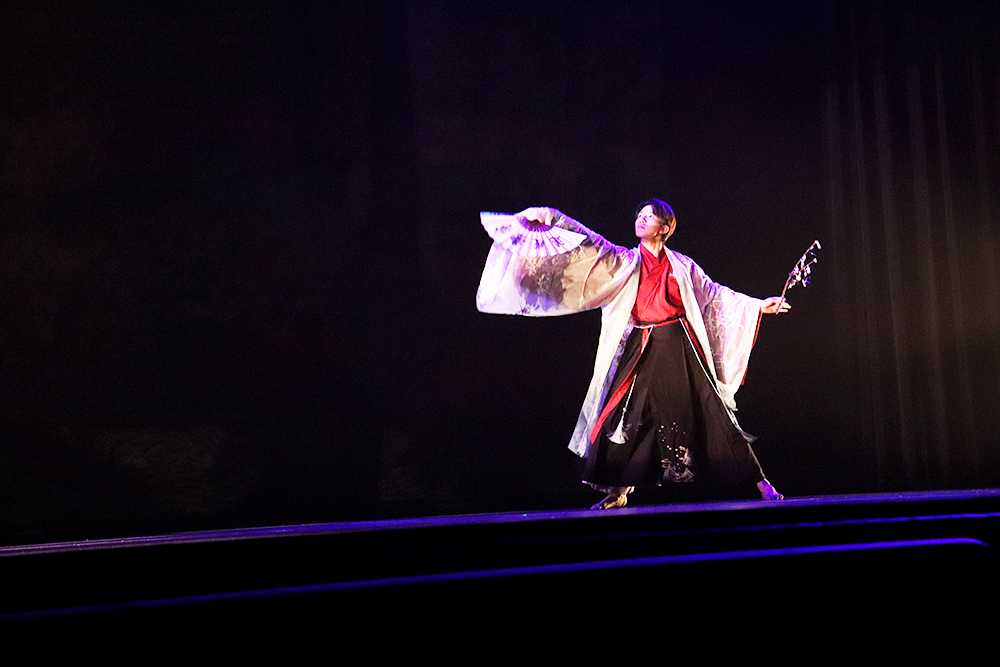The 19th annual International Dance Fest was hosted on Feb. 11 at the Collins Center of the Arts. The show was shown twice, once at 2 p.m. and the other at 7 p.m. The program lasted about two hours, with a brief intermission in between the two acts.
The Masters of Ceremony, Sonja Birthisel and Taylor Ashley, came out first to hype the crowd. They started the show with party music. Ashley, decked out in an orange coat, busted out the worm. These outfits were changed by the time they came out after the first act.
The acts range from emotional performative dances, energetic pieces and traditional dances. Many pieces were solos or duets, with a few ensemble pieces towards the end of each act.
The Dance Fest featured 12 acts, each with music and style from the dancer’s country of origin.
Each act had fitting costumes to go along, all having their own unique style and design.
Countries represented at the Dance Fest were China, Turkey, Peru, Bangladesh, Nigeria, Nepal, Cambodia and Columbia. China had the most dances, with four separate acts.
The Festival started with a dance from Megan Lu, titled “Xi.” The dance was an emotional piece with Lu displaying sorrowful movements.
Closing the first act was the “Dance in the Morning Light,” performed by a group of four dancers of the greater Bangor area. The dance portrayed Shanghai in the 1930s, as four housewives went about morning chores. The women moved gracefully around the stage, at one point dancing atop small stools.
In the second act were two more Chinese dances. The first of these was a duet titled “Guan Shan Jiu.” The dance was said to embody longing for the good old days, as well as having a close friend that is now far away. The pair spent the first part of the dance in sync, although keeping a distance from each other. They moved around but never interacted. They then switched to the second part of the dance, which was slightly more upbeat and incorporated paper fans that they danced with.
The last Chinese dance was a solo piece from Zhiwei Liu and was titled “Dong Du (To the Realm of Mind and Spirit).” This piece, as introduced by Taylor, depicts a Chinese myth of an island that contains an herb of immortality. A group goes missing searching for the island. The dance was elegant, with Liu’s flowing robes adding to the movement of the piece.
The other country to have more than one dance was Turkey. Two Turkish dances were showcased in the program, one in each act.
The first was a traditional belly dance, titled “Šeherezáda” and was the second act of the show. Two dancers, one dressed in red and one in blue, brought energy to the audience as they moved around with tambourines. The dance was said to have originated in Romani culture.
“Roma people still have an influence on Turkey,” Ashley said.
The other dance from Turkey was the final piece of the show. The largest ensemble piece, the dance titled “Damat Halayi” is a traditional dance done at weddings, parties and other gatherings. The nine performers danced fast and excitedly in a line, repeating steps as the music got faster and faster.
Along with the two dances of Turkish origin, this year’s International Dance Festival aimed to raise money for relief in Turkey and Syria. The countries were hit by devastating earthquakes early last week. Donations taken outside and proceeds from concessions go to NGO non-profits and split between the two countries.
“Everywhere is destroyed and I’m looking back at where I grew up and it’s so hard for me,” Hira Avci, an international student from Turkey and president of the International Business and Culture Club, said.
Avci was not a dancer in the program but came up to talk about Turkey and the impact the earthquakes had.
Other highlights of the Dance Fest was the traditional Maiden Dance from Nigeria. Dancer Chisom Orakwue brought an energized dance full of rapid body movements. She had a visible grin the entire way through her dance.
Ana Jimenez Lagos from Peru danced “Reggaeton,” inspired by the streets of Latin America.
“The streets are part of us,” the description of her dance read.
One of the other ensemble pieces was the Salsa from Colombia. Eight members danced, split between four boys and four girls.
The International Dance Fest is hosted once a year. This is the 19th iteration of the program, with the first instance being in 2005. The University of Maine has over 500 international students, many of which showed up to watch the show. While this year’s Dance Fest is over, there are sure to be more unique dances next year for students to enjoy.










